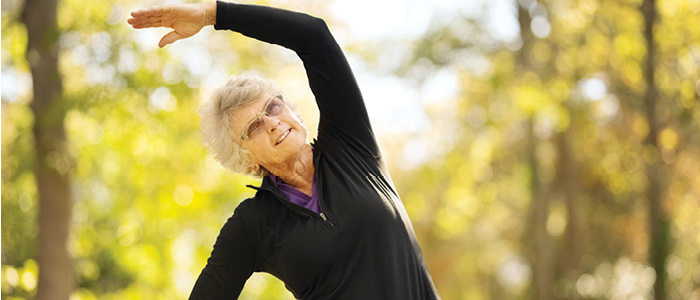The current “Stay at Home” COVID-19 order can make it challenging to stay active. But exercise is the key to healthy aging, so our community partner, the Lititz recCenter, has provided some tips…
Fitness Classes
During this time of “distancing,” the training staff at Lititz recCenter is providing a variety of fitness activities on their website at http://lititzrec.com/fitness-from-a-distance/. On this page, scroll down to these three free classes:
• SilverBalance (for stability, balance, and posture)
• SilverYoga (for flexibility, breathing, and meditation)
• SilverStrong (an advanced class to improve the cardio and strength)
Staying Limber
Staying flexible and limber as we age can help increase range of motion and make everyday tasks easier. Daily stretching may allow for greater movement in joints and improves posture. It also helps to release muscle tension and soreness, and reduces the risk of injury. Lastly, it may also help increase circulation, muscle control, and improve balance and coordination. Stretching is convenient, requires minimal equipment, and can be done anywhere.
The Lititz recCenter offers the following stretching tips:
• Take a deep breath and slowly exhale as you stretch.
• Hold each stretch for 20 to 30 seconds to give the muscle ample time to relax.
• Don’t bounce while you stretch, as this increases your risk of injury.
• Only stretch until you feel tension in the muscle, not to the point of pain.
• Always warm up before stretching by moving around for 5 to 10 minutes, such as going for a walk.
Neck Stretch
Stretch the neck by slowly bringing your chin toward your chest and turning your head side to side (Hold each position for 15 seconds)
Chest Stretch
Stretch your chest by extending both arms to the side, palms facing forward.
Ankle Stretch
Stretch your ankles by sitting in a chair and slowly moving your foot up and down and side to side.
Hold each position 30 seconds and repeat on other foot.
Hamstring Stretch
Lie on your back and extend one leg perpendicular to your body.
Grasping around the back of your thigh, slowly pull the leg towards you, keeping your other leg and hip on the ground. Do not pull on your knees when stretching.
Quadriceps Stretch
Start your hips by lying on your back, bringing one knee out to the side of your body.
Pull your foot towards your body until you feel a stretch. You can use a belt or a towel to help if you cannot reach your foot, and this can be done in a standing position as well.
Hip Stretch
Stretch your hips by lying on your back, bringing one knee out to the side of your body.
Lower Back Stretch
Stretch your lower back by lying on your back, knees bent and feet together. Keep feet flat on the floor. Keeping knees together, lower your legs to one side, twisting your torso until your feel a stretch. Hold and repeat on other side.
Tips for Tight Muscles
Any new exercise or even stretching exercises can lead to tight muscles. These tips can help alleviate any soreness one experiences. If your pain persists, consult your physician. Stop and call 911 if you experience major muscles pain, dizziness or Nausea.
1. The Rice Principle
You may feel some muscle soreness when you begin a regularly scheduled exercise program. This is possibly due to the lack of conditioning and or/ overexertion. If you experience any musculoskeletal injury or soreness, stop exercise and follow the “RICE” principle.
• Rest
• Ice the area for roughly 15 minutes then wait 15 minutes before reapplying.
• Compression: Secure a bandage to hold the ice firmly around the injured area.
• Elevate the injures area. If the pain persists – consult your physician.
2. Exercise Safety
• Always warm-up and cool-down
• Start slowly and progress gradually
• Drink plenty of water… before, during and after.
• Breathe evenly and never hold your breath.
• Maintain proper body alignment and avoid lifting too much weight.
• Don’t over train… rest days are important.
3. Flexibility Component
• Frequency: 3 to 7 days per week. Stretching is encouraged after each exercise session, during the cool-down phase.
• Intensity: Stretch each muscle to the point of slight discomfort, do not bounce.
• Time: Hold each stretch for at least 15 to 30 seconds. Hold the stretch, not your breath.
• Type: Any slow stretch that incorporate each muscle group of the body.
• What You Should Know: Specific stretches will be personalized for each participant if necessary, based on their health history and musculoskeletal limitations. Stretches should be held steady.
4. Benefits of Stretching Exercises
• Increases flexibility and enhances coordination.
• Improves posture, joint mobility and circulation
NOTE: Always consult a doctor before starting a new exercise routine. If you have any muscle or joint injuries or previous surgeries, be sure to ask your doctor or physical therapist what stretches are best for you. Never stretch to the point of pain or hold your breath d

